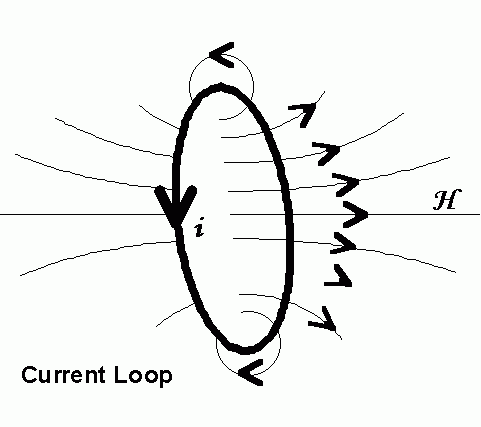1. Definitions and Units
Let's start with a few definitions. There are three magnetic vectors:
- H Magnetic field
- M Magnetization
- B Magnetic induction
There is some confusion in the literature over units. SI units are now the preferred units over the older CGS. Confusion prevails because there are two ways that magnetostatics is presented:
- fictitious magnetic poles (CGS: centimeter, gram, second)
- current sources (SI: systme internationale)
As a result, the form of many of the basic equations are different between the two systems. What this all means is that some arbitrary constant has units in one system but is equal to unity and dimensionless in the other system. There are also factors of 4p floating around.
The difference between the pole and current approach is only significant in the subject of units. The older (pre 1980) paleomagnetic and rock magnetic literature is primarily in CGS units.
Because SI are now the units of choice, we begin with current loops. Consider a loop of radius r and current i, roughly equivalent to an atom with orbiting electrons.

A magnetic field H will be produced at the center of the loop given by
H = i/2r [Amperes/meter, A/m]
The current loop has a magnetic moment, m, associated with it
m = i x Area [Am2]
The intensity of magnetization, M or J, is magnetic moment per unit volume
M = m/v [A/m]
Note that M and H have the same units.
Magnetic moment per unit mass, σ, is
σ = m/mass [Am2/kg]
Another fundamental quantity is the ratio of magnetization to magnetic field, which is called the susceptibility
κ = M/H [dimensionless]
The mass susceptibility is
χ = σ/H = κ/density [ m3/kg].
Susceptibility is a measure of how magnetizable a substance can become in the presence of a magnetic field and can be used in a general way to describe the various classes of magnetic materials. A related quantity, denoted by μ, relates B to H and is called the permeability (Engineering types use permeability instead of susceptibility).
In the SI system, the relationship between B, H and M is given by
B = μo(H+M) [Tesla, T]
The B unit is called the Tesla and the total B field is the sum of the H field and the magnetization M of the medium. The constant μo is called the permeability of free space. In SI it is equal to 4π x 10-7 Henry / m.
However, in CGS, μo is set equal to unity, which makes B and H, and M numerically equal to one another, but each have different unit names (arbitrarily chosen and named after famous dead people, Gauss, Oersted, and emu/cm3). The CGS equation is
B = H+4πM
Herein lies some of the confusion, because in CGS, B and H are used interchangeably, but the unit conversions going to SI give different numerical values. For example, the earth's field is 0.5 Gauss or 0.5 Oe. However, in SI
0.5 Gauss = 50 μT [B fields]
0.5 Oersted = 39.8 A/m [H fields].
As you can see from this example, it is much easier to convert Gauss to Tesla (move the decimal point 4 places) than to convert Oersted to A/m. So it is not too surprising that this is the current practice used by paleomagnetists to report all fields (B and H) in Tesla. We have not decided suddenly that the B field is more fundamental than the H field (neither field is any more fundamental than the other). Actually, when we talk about an alternating "field", or a magnetic "field", of say 100 milliTesla (mT), we really mean μoH = 100 mT. However, this is rarely noted.
I have summarized the comments about units in Table 1.
| Magnetic Term | Symbol | SI unit | CGS unit | conversion factor |
|---|---|---|---|---|
| magnetic induction | B | Tesla (T) | Gauss (G) | 1 T = 104 G |
|
magnetic field
|
H | A/m | Oersted (Oe) | 1 A/m =4π/103 Oe |
| magnetization | M | A/m | emu/cm3 | 1 A/m = 10-3 emu/cm3 |
| mass magnetization | σ | Am2/kg | emu/g | 1 Am2/kg = 1 emu/g |
| magnetic moment | m | Am2 | emu | 1 Am2 = 103emu |
| volume susceptibility | κ | dimensionless | dimensionless | 4π (SI) = 1 (cgs) |
| mass susceptibility | χ | m3/kg | emu/Oe·g | 1 m3/kg = 103/4π emu /Oe·g |
| permeability of free space |
μ0 | H/m | dimensionless | 4πx10-7 H/m = 1 (cgs) |
A= Ampere
cm= centimeter
emu= electromagnetic unit
g= gram
kg= kilogram
m= meter
H= Henry
For more information on SI and CGS units in magnetism see:
M.A. Payne (1981), Phys. Earth Planet Inter., 26, P10-P-16, with errata (1981), Phys. Earth Planet. Inter., 27, 233.
P.N. Shive (1986), Transactions American Geophys. Union (EOS), 67, 25.